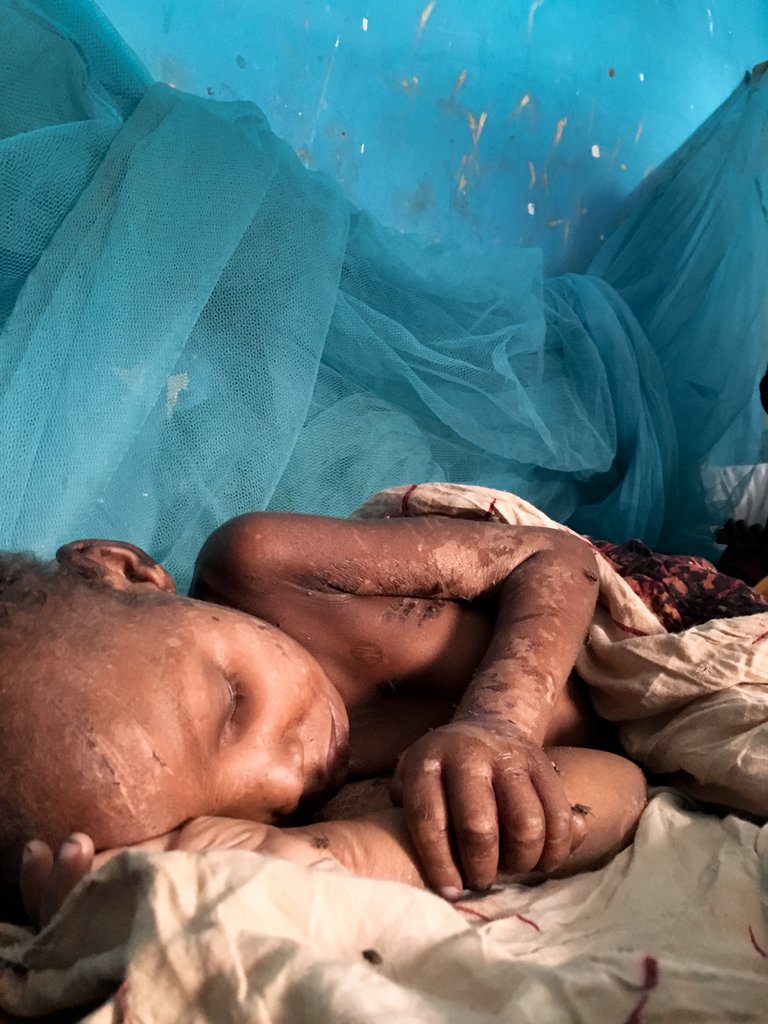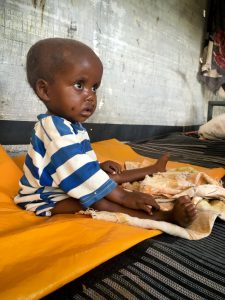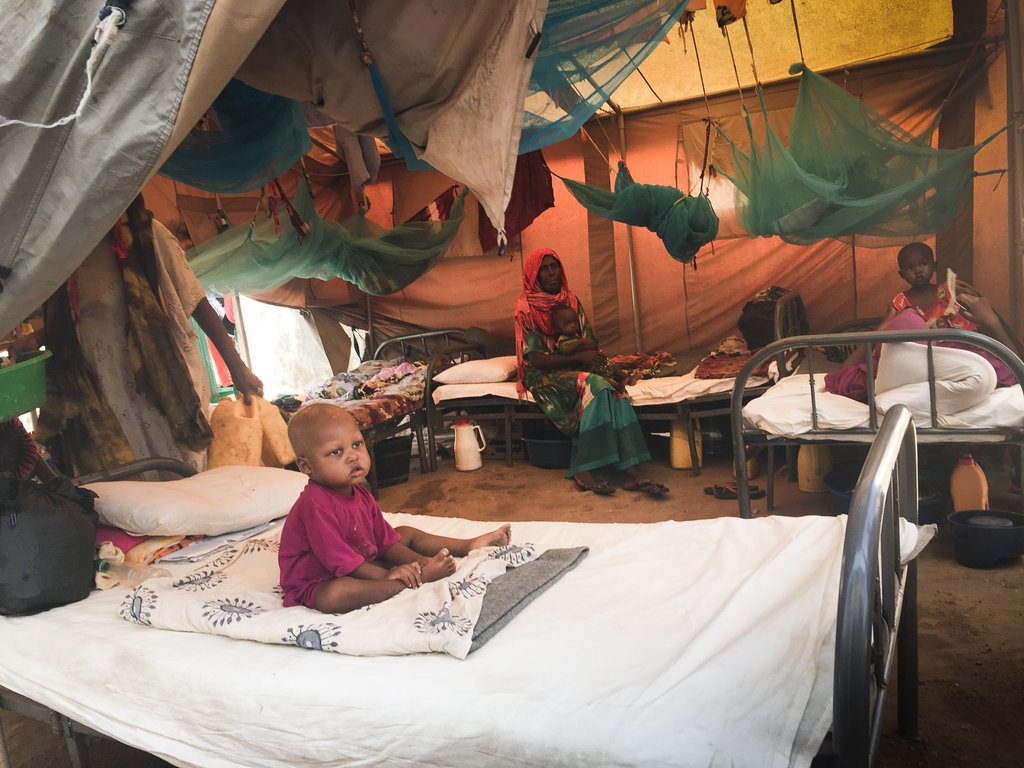More than 300,000 children in Somalia are malnourished, including nearly 60,000 under the age of five who are in critical condition and need urgent therapeutic feeding. In Kismayo, a port city in southern Somalia, the only feeding center in the region is overwhelmed by the number of children seeking assistance through its nutritional therapeutic feeding program.

Four-year-old Osman Jaafar is suffering from kwashiorkor, a nutritional disorder that has caused a flaky rash all over his body giving his skin a rusty colour and textrure. ©ICRC/Abdikarim Mohamed
Four-year-old Osman Jaafar lies lifeless next to his mother. He came to the centre in February suffering from Kwashiorkor, a nutritional disorder caused by lack of protein in the diet. He has developed a flaky rash all over his body, and his skin’s colour and texture have grown a rusty look. Fortunately he is responding to the daily nutritional doses and is expected to fully recover.
His mother, Madina Mohamed Amin, spends most of her time seated right by her boy’s side. She managed to save 10USD to cover expenses for the trip from Jamame district, about 75km away. Her husband stayed behind to take care of their other four children.
Osman’s family resides in the flood-prone area along Juba River. Seasonal flooding that accompany the rains usually disrupt the food security of the riverine communities. According to the stabilization center’s records, almost 60 percent of the children admitted between January and February, like Osman, are from that community.
The right side of 2-year-old Abdi Ibrahim’s face is covered with bandages to hold in place a nasal feeding tube.
The boy, who was admitted in late February after a two-day journey, lies frail on his mother’s lap and seems motionless amidst the crowded surroundings. Abdi is also suffering from Kwashiorkor but his case is coupled with anemia and a lack of appetite.
Ironically and somewhat cruelly, Abdi is actually overweight due to oedema, a condition characterized by fluid retention which has caused swelling in his body. He came in weighing 7kg and the nurses are optimistic he’ll get down to 6kg, which is his ideal weight.
Abdi, one of eight children, travelled 90km with his mother, Baaba Hussein, from Kanjaron district to receive treatment at the centre. The family leads a nomadic lifestyle and depends on livestock for sustenance. However their livestock are now thin and unhealthy because of recurrent drought in the lower Juba region, and the family has resorted to a diet of maize and water to survive.

Timiro Ali, two years old, lives with her family in one of the 42 displaced camps within Kismayo town. ©ICRC/Abdikarim Mohamed
Timiro, 2, lives with her family in one of the 42 displaced camps in and around Kismayo city. She was admitted in early February severely malnourished and suffering from tuberculosis, a bacterial disease. She is at the centre with her 13-year-old sister, Sahra Ali, because her mother had to stay behind in the camp and fend for the remaining seven children.
The good news is that Timiro is slowly recovering. She has been gradually gaining weight since being placed under the therapeutic feeding program. The nurses are hopeful she will be discharged soon.
According to a 2016 humanitarian needs overview report, acute malnutrition rates in internally displaced settlements like Timiro’s are “frequently above the emergency threshold of 15 percent.”
The Kismayo Stabilization Centre is full of such stories. In January and February, the center was treating 150 malnourished children, a figure that far exceeds the 90-bed capacity. During those months 386 children under the age of five were admitted to the centre, leading to an overcrowding problem so dire that the centre’s general supervisor, Bashir Mohamed, had to convert some staff offices into wards.
“We began by converting the isolation ward to a normal ward and now we had to make room in some offices to deal with the high admissions. Remember that the children are accompanied by the parents or caregivers who will stay with them for the duration of the treatment, “said Mohamed.

One of the tents put up outside the Kismayo stabilization centre to accomodate the high number of patients admitted in the facility. ©ICRC/Abdikarim Mohamed
The Kismayo Stabilization Centre is so overwhelmed in part because three similar centers in the Juba region have closed down in recent years. The International Committee of the Red Cross (ICRC) began supporting the Kismayo Stabilization Centre in 2014.
ICRC supports another stabilization centre in Baidoa, Bay region that opened in May 2015. The malnutrition problem there is just as dire.
Despite their hardships, the mothers and care givers can at least leave the two centres with some sound advice on proper feeding habits for the children. Upon discharge, supplementary foods such as specially prepared peanut-based paste (Plumpy’nut) are given to the mothers. Furthermore, families are provided with seeds and training on how to grow tomatoes, beans and carrots to sustain a healthy diet. The ICRC also provides 300 USD cash assistance to the mothers to make up for the lost income for the period they were receiving treatment. The transport cost to the centre is reimbursed and fare back home is also provided.
Last year, the two centres treated over 3,000 cases of severely malnourished children. In a time of rising malnutrition, the centres remain critical to the care of the children.


